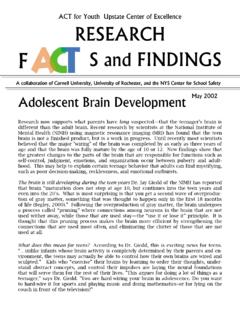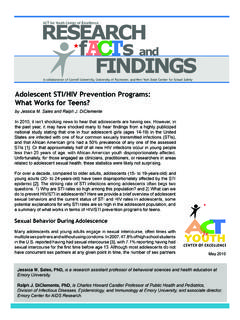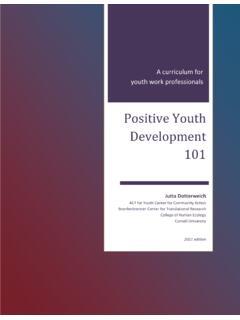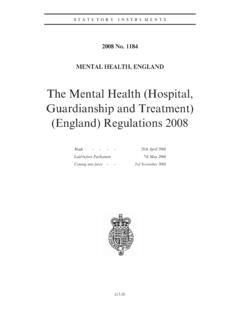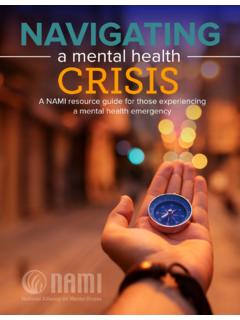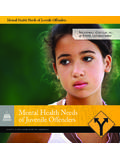Transcription of Mental Illness and Mental Health in Adolescence
1 Mental Illness and Mental Health in AdolescenceDecember 2008by Janis Whitlock and Karen SchantzAs any parent, youth worker, or young adult can verify, Mental Health in Adolescence may be characterized by a roller coaster of emotional and psychological highs and lows. Intense feelings are a normal and healthy part of the psychological landscape of youth, but it is also true that many Mental Health disorders of adulthood begin in childhood or Adolescence . While the Mental Health field offers essential options for treating disorders, the profession is only beginning to explore ways to build optimum Health . This fact sheet provides a very brief introduction to Mental Health with a focus on definition, assessment, and Mental Health disorders, then offers perspective on the role youth development approaches may play in promoting positive Mental Health and protecting against Mental Health and Assessing Adolescent Mental HealthThe term Mental Health generally refers to a psychological and emotional state.
2 Like the states of mind and being it reflects, the term is fluid and is used to discuss a) a positive state of psychological and emotional well-being and the conditions that foster it, b) the absence of Mental Illness , or c) the presence of Mental imbalances that affect overall psychological well-being. Assessing Mental Health may be equally ambiguous and context-dependent. How do we know if an individual is psychologically and emotionally thriving, thus enjoying positive Mental Health ? How do we know if a person is struggling with a Mental Health disorder? The task of evaluating whether a young person is experiencing chronically negative trends in psychological and emotional well-being is complicated by the fact that fluctuations in mood and behavior are normal in Adolescence . Because of this, and because of the need to ensure that youth at risk for Mental Illness or disorders receive the attention they need, it is most common to assess Mental Health as either the absence or presence of Mental Illness rather than through a more positive lens.
3 Mental Health DisordersMental Health problems affect one in every five young people at any given time ( Department of Health and Human Services, 1999) although severity varies greatly. Individuals are regarded as possessing a serious emotional disturbance ACT for Youth Center of Excellence A collaboration of Cornell University, University of Rochester, and New Yo rk State Center for School Safety2 Resources: Coping with Mental Health DisordersAmerican Academy of Child & Adolescent Psychiatry: Facts for Families Extensive series of briefs on a wide variety of behaviors and issues affecting School Mental Health ProjectClearinghouse for resources on Mental Health in schools, including systemic, programmatic, and psychosocial/ Mental Health General s Report on Mental HealthIncludes a chapter on children and Mental Involvement in Systems of CareBlueprints for local systems of care that are seeking to increase youth a Mental disorder disrupts daily functioning in home, school, or community.
4 If a child or adolescent is able to function well in at least two of those three areas, it is unlikely that he or she has a serious Mental Health disorder. It is estimated that one in ten young people in the United States experiences a serious emotional disturbance at some point in their childhood or Adolescence . Recognition of the signs and symptoms of Mental Health disorders is important because early intervention may be critical to restoring Health . Mental Health disorders are typically marked by disruption of emotional, social, and cognitive functioning. Those disorders that most commonly affect Adolescence are anxiety disorders, which manifest through phobias, excessive worry and fear, and nervous conditions; and depression disorders, characterized by states of hopelessness or helplessness that are disruptive to day-to-day life. Other Mental Health conditions affecting youth include bipolar disorder, conduct disorder, attention-deficit/hyperactivity disorder, learning disorders, eating disorders, autism, and childhood-onset schizophrenia.
5 Causes of Mental IllnessAlthough it is often possible to identify triggers for particular episodes of Mental Illness , identifying the underlying etiology is often more difficult. In many cases, Mental Illness emerges as a consequence of biological and environmental interactions. For example, the predisposition for disorders such as schizophrenia, bipolar disorder, and depression are genetically heritable and may be activated by particular environments (Pickler, 2005). Environmental factors that lead to chemical imbalances in the body or damage to the central nervous system may also create biological vulnerabilities. When these vulnerabilities are coupled with environmental conditions high in chaos and low in security and safety (such as exposure to violence, including witnessing or being the victim of abuse; stress related to chronic poverty, discrimination, or other serious hardship; and the loss of important people through death, divorce, or broken relationships), Mental disorders may result (Perry, 2002).
6 However, it is important to note that while research on the etiology of Mental Illness has been fruitful, not all individuals at risk for Mental Illness develop it and many individuals with no apparent risk do. Also, having a genetic predisposition does not mean that developing a Mental Illness is predetermined or that parents with a similar condition are to blame. Much remains to be learned in this of Disorder Mental Health disorders seldom simply appear in full bloom. Instead, they are often preceded by symptoms of deteriorating Health and functioning. The primary differences between developmentally common behavior and nascent Mental Health disorders are in 3symptom severity and duration, and the extent to which the behavior causes disruption to daily life. Early onset Mental disorders may be episodic at first, but tend to increase in severity, duration, and level of disruption over time.
7 Family members and friends are often the first to notice early symptoms. It is important to recognize that perceptions of what constitutes good or poor Mental Health will vary from culture to culture. Such variation may affect how serious disorders are expressed, detected, and interpreted. Sensitivity to cultural difference is critical to effective detection, intervention, prevention, and treatment. TreatmentPsychotherapeutic interventions such as cognitive behavior therapy and family systems therapy are currently the most widely used and effective treatments for most Mental illnesses. While they may be added to these interventions, medications typically should not be used as the sole treatment; however, selective serotonin reuptake inhibitors (SSRIs) are widely used and generally considered safe.
8 Fortunately, widespread and growing awareness of the prevalence of Mental Health disorders in children and adolescents has spurred the search for therapeutic and pharmacological approaches that are safe and effective for youth. Internet resources such as those offered by the American Academy of Child and Adolescent Psychiatry (see ) provide valuable resources for families and others seeking updated information on Mental Health disorders and Mental Illness : Promoting Mental Health and Well-BeingUnderstanding signs and symptoms of Mental Health disorders is important for early detection and intervention. It is also important, however, to define and research Mental Health in positive terms (rather than merely the absence of Illness ) and to promote well-being through affirming, strength-based approaches. Positive Psychology: Developing Mental Health in Young PeopleWith so much emphasis on disorder, we might well wonder if freedom from Illness is the best we can hope for.
9 The emerging field of positive psychology seeks to bring balance to Mental Health research through the study and promotion of psychological strengths. Linking youth development to the positive psychology framework, the Commission on Youth Voice in Systems of CareIncreasingly, youth and family engagement is recognized as an essential element of Mental Health interventions. As Matarese, McGinnis, and Mora point out (2005), just as families have advocated for and achieved critical roles in their children s Mental Health care, young people and their allies are gaining ground in the movement to involve youth at every level of the Mental Health care system. Youth participation in the transformation of Mental Health care systems will help to combat stigma and isolation, and will create opportunities for young people to develop a stronger sense of belonging, purpose, and self-esteem.
10 Benefits reach beyond the individual: the entire system profits when youth are given opportunities to make authentic contributions to quality of care. For an excellent resource offering the history and rationale behind the youth movement, as well as blueprints for local systems of care that are seeking to increase youth involvement, see Youth Involvement in Systems of Care: A Guide to Empowerment. 4 Positive Youth Development (2006) summarizes positive psychological characteristics in five broad categories: Positive emotions, including joy, contentment, and love Flow, defined as the psychological state that accompanies highly engaging activities Life satisfaction; the sense that one s own life is good, which correlates with characteristics such as self-esteem, resiliency, optimism, self-reliance, healthy habits, and prosocial behaviorCharacter strengths such as curiosity, kindness, gratitude, humor, and optimismCompetencies in the social, emotional, cognitive, behavioral, and moral realmsThese characteristics gesture toward a much more vibrant vision of Mental Health , and are suggestive of ways concerned communities might create supports, opportunities, and services to promote optimum Health .




